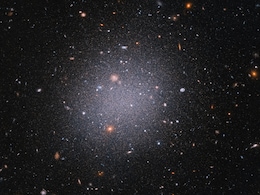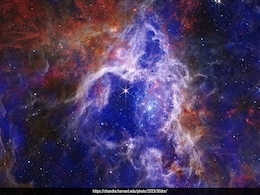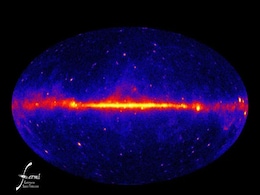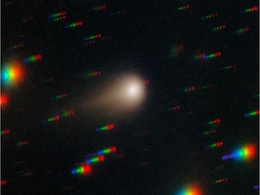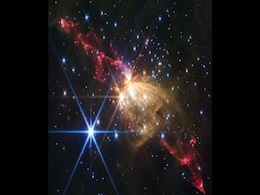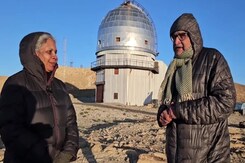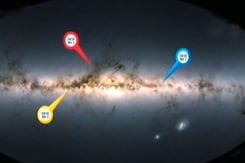Milky Way
- All
- News
- Videos
- Web Stories
-

Indian Scientists Discover Ancient Milky Way-Like Galaxy Alaknanda With Spiral Arms
- Wednesday December 3, 2025
- World News |
Indian scientists have discovered an ancient and massive galaxy called Alaknanda. It looks similar to our Milky Way galaxy and is special because it has clear spiral arms, even though it formed when the universe was only 1.5 billion years old.
-
 www.ndtv.com
www.ndtv.com
-

Indian Team Finds 53 Massive Quasars Blasting Jets Millions of Light-Years Long
- Tuesday December 2, 2025
Astronomers in India have identified 53 previously unknown giant radio quasars powered by supermassive black holes, each releasing enormous plasma jets reaching up to 7.2 million light-years—nearly 50 times the Milky Way’s diameter. Using GMRT data, the team expanded the catalog of known giant quasars and offered valuable clues about how black ...
-
 www.gadgets360.com
www.gadgets360.com
-

Fermi Telescope Detects Gamma-Ray Halo That Could Be First Direct Dark Matter Signal
- Saturday November 29, 2025
NASA’s Fermi Gamma-ray Space Telescope has detected a faint halo of high-energy gamma rays around the Milky Way’s centre—matching predictions for dark-matter annihilation. The finding, reported by Professor Tomonori Totani, could represent the first direct glimpse of dark matter, but scientists caution that alternative explanations remain and...
-
 www.gadgets360.com
www.gadgets360.com
-

Scientists May Have Caught The First Real Glimpse Of Dark Matter, Universe's Most Elusive Ingredient
- Wednesday November 26, 2025
- Science |
The new study led by Prof Tomonori Totani of the University of Tokyo analysed Fermi telescope observations of the Milky Way's centre - the region where dark matter is expected to be densest.
-
 www.ndtv.com
www.ndtv.com
-

Dark Matter May Have Been Seen for the First Time in NASA Gamma-Ray Data
- Wednesday November 26, 2025
A new analysis of NASA’s Fermi telescope data reveals a faint gamma-ray halo around the Milky Way’s core, matching predictions for annihilating dark-matter particles. Researchers say no known astrophysical source fits the signal, raising the possibility of the first direct evidence of dark matter. Experts, however, stress caution and call for v...
-
 www.gadgets360.com
www.gadgets360.com
-

NASA’s Nancy Grace Roman Space Telescope Surpassing Expectations Even Before Launch, Reveals Research
- Tuesday November 25, 2025
NASA’s upcoming Roman Space Telescope is expected to measure seismic waves in over 300,000 red giant stars, far greater than early predictions. These signals will help scientists better understand exoplanet systems and the Milky Way’s ancient core. Researchers say Roman’s natural survey design enables this breakthrough even before the telesco...
-
 www.gadgets360.com
www.gadgets360.com
-

Extreme Star Factory: ALMA Detects Galaxy Y1 Forming Stars 180 Times Faster Than the Milky Way
- Wednesday November 19, 2025
Using ALMA’s ultra-sensitive Band 9 observations, astronomers identified galaxy Y1 as an extreme star-forming system in the early universe. Producing stars at 180 solar masses per year, Y1 reveals how intense, short-lived starbursts helped shape young galaxies and may have been more common than previously believed.
-
 www.gadgets360.com
www.gadgets360.com
-

For The First Time, Scientists Spot Life's Essentials Frozen In A Distant Galaxy
- Saturday October 25, 2025
- Science |
Scientists have discovered complex organic molecules, including acetic acid and ethanol, frozen in ice beyond the Milky Way, suggesting that life's chemical ingredients may be widespread across the universe.
-
 www.ndtv.com
www.ndtv.com
-

Flattened Dark Matter May Explain Mysterious Gamma-Ray Glow at Milky Way’s Core, Study Finds
- Sunday October 26, 2025
Dark matter near the Milky Way’s center appears flattened, not spherical, according to new simulations. The discovery may explain a puzzling gamma-ray glow long observed by NASA’s Fermi telescope, reigniting theories that dark matter collisions produce high-energy radiation in the galaxy’s core
-
 www.gadgets360.com
www.gadgets360.com
-

"Once-In-A-Lifetime": Rare Red Lightning Captured Over New Zealand's Skies, See Pic
- Wednesday October 22, 2025
- Science |
Red sprites are brief, large-scale electrical discharges that occur high above thunderstorms, reaching altitudes of up to 90 kilometers.
-
 www.ndtv.com
www.ndtv.com
-

Scientists May Have Come Closer To Confirming Dark Matter's Existence, New Study Finds Clue
- Tuesday October 21, 2025
- Science |
The study notes that if excess gamma light is not from dying stars, it could become the first proof that dark matter exists.
-
 www.ndtv.com
www.ndtv.com
-

Interstellar Comet 3I/ATLAS May Originate from Milky Way’s Hidden Frontier, New Study Suggests
- Sunday October 12, 2025
A new study proposes that interstellar comet 3I/ATLAS may have originated in the thick disk region of the Milky Way, a lesser-known frontier beyond the spiral arms. Observations of its composition and trajectory support this possibility. Detailed telescopic messages from this visitor may help unravel the structure and evolution of our galaxy.
-
 www.gadgets360.com
www.gadgets360.com
-

James Webb Telescope Unveils Hidden Star-Forming Regions in Sagittarius B2
- Wednesday October 1, 2025
New JWST observations reveal the hidden star-forming activity inside Sagittarius B2, the Milky Way’s largest molecular cloud. By seeing through dense dust, astronomers can study how stars form efficiently in extreme environments. These findings help explain not only Sgr B2 but also broader mechanisms shaping galaxies.
-
 www.gadgets360.com
www.gadgets360.com
-

White Dwarf Gobbles Up Nitrogen-Rich Ices of Pluto-Like World
- Friday September 26, 2025
- World News | Reuters
Astronomers have observed a white dwarf, a highly compact stellar ember, that appears to have gobbled up an icy world akin to dwarf planet Pluto, a finding with implications regarding the likelihood of habitable planets beyond our solar system
-
 www.ndtv.com
www.ndtv.com
-

James Webb Space Telescope Spots Rare Protostar Blasting Twin Jets Across Milky Way
- Friday September 12, 2025
NASA’s James Webb Space Telescope has captured a rare protostar about ten times the Sun’s mass blasting twin jets nearly eight light-years long. The beams carve through the glowing Sharpless 2-284 nebula, offering astronomers a vivid glimpse into how massive stars form and shape their galactic environment.
-
 www.gadgets360.com
www.gadgets360.com
-

Indian Scientists Discover Ancient Milky Way-Like Galaxy Alaknanda With Spiral Arms
- Wednesday December 3, 2025
- World News |
Indian scientists have discovered an ancient and massive galaxy called Alaknanda. It looks similar to our Milky Way galaxy and is special because it has clear spiral arms, even though it formed when the universe was only 1.5 billion years old.
-
 www.ndtv.com
www.ndtv.com
-

Indian Team Finds 53 Massive Quasars Blasting Jets Millions of Light-Years Long
- Tuesday December 2, 2025
Astronomers in India have identified 53 previously unknown giant radio quasars powered by supermassive black holes, each releasing enormous plasma jets reaching up to 7.2 million light-years—nearly 50 times the Milky Way’s diameter. Using GMRT data, the team expanded the catalog of known giant quasars and offered valuable clues about how black ...
-
 www.gadgets360.com
www.gadgets360.com
-

Fermi Telescope Detects Gamma-Ray Halo That Could Be First Direct Dark Matter Signal
- Saturday November 29, 2025
NASA’s Fermi Gamma-ray Space Telescope has detected a faint halo of high-energy gamma rays around the Milky Way’s centre—matching predictions for dark-matter annihilation. The finding, reported by Professor Tomonori Totani, could represent the first direct glimpse of dark matter, but scientists caution that alternative explanations remain and...
-
 www.gadgets360.com
www.gadgets360.com
-

Scientists May Have Caught The First Real Glimpse Of Dark Matter, Universe's Most Elusive Ingredient
- Wednesday November 26, 2025
- Science |
The new study led by Prof Tomonori Totani of the University of Tokyo analysed Fermi telescope observations of the Milky Way's centre - the region where dark matter is expected to be densest.
-
 www.ndtv.com
www.ndtv.com
-

Dark Matter May Have Been Seen for the First Time in NASA Gamma-Ray Data
- Wednesday November 26, 2025
A new analysis of NASA’s Fermi telescope data reveals a faint gamma-ray halo around the Milky Way’s core, matching predictions for annihilating dark-matter particles. Researchers say no known astrophysical source fits the signal, raising the possibility of the first direct evidence of dark matter. Experts, however, stress caution and call for v...
-
 www.gadgets360.com
www.gadgets360.com
-

NASA’s Nancy Grace Roman Space Telescope Surpassing Expectations Even Before Launch, Reveals Research
- Tuesday November 25, 2025
NASA’s upcoming Roman Space Telescope is expected to measure seismic waves in over 300,000 red giant stars, far greater than early predictions. These signals will help scientists better understand exoplanet systems and the Milky Way’s ancient core. Researchers say Roman’s natural survey design enables this breakthrough even before the telesco...
-
 www.gadgets360.com
www.gadgets360.com
-

Extreme Star Factory: ALMA Detects Galaxy Y1 Forming Stars 180 Times Faster Than the Milky Way
- Wednesday November 19, 2025
Using ALMA’s ultra-sensitive Band 9 observations, astronomers identified galaxy Y1 as an extreme star-forming system in the early universe. Producing stars at 180 solar masses per year, Y1 reveals how intense, short-lived starbursts helped shape young galaxies and may have been more common than previously believed.
-
 www.gadgets360.com
www.gadgets360.com
-

For The First Time, Scientists Spot Life's Essentials Frozen In A Distant Galaxy
- Saturday October 25, 2025
- Science |
Scientists have discovered complex organic molecules, including acetic acid and ethanol, frozen in ice beyond the Milky Way, suggesting that life's chemical ingredients may be widespread across the universe.
-
 www.ndtv.com
www.ndtv.com
-

Flattened Dark Matter May Explain Mysterious Gamma-Ray Glow at Milky Way’s Core, Study Finds
- Sunday October 26, 2025
Dark matter near the Milky Way’s center appears flattened, not spherical, according to new simulations. The discovery may explain a puzzling gamma-ray glow long observed by NASA’s Fermi telescope, reigniting theories that dark matter collisions produce high-energy radiation in the galaxy’s core
-
 www.gadgets360.com
www.gadgets360.com
-

"Once-In-A-Lifetime": Rare Red Lightning Captured Over New Zealand's Skies, See Pic
- Wednesday October 22, 2025
- Science |
Red sprites are brief, large-scale electrical discharges that occur high above thunderstorms, reaching altitudes of up to 90 kilometers.
-
 www.ndtv.com
www.ndtv.com
-

Scientists May Have Come Closer To Confirming Dark Matter's Existence, New Study Finds Clue
- Tuesday October 21, 2025
- Science |
The study notes that if excess gamma light is not from dying stars, it could become the first proof that dark matter exists.
-
 www.ndtv.com
www.ndtv.com
-

Interstellar Comet 3I/ATLAS May Originate from Milky Way’s Hidden Frontier, New Study Suggests
- Sunday October 12, 2025
A new study proposes that interstellar comet 3I/ATLAS may have originated in the thick disk region of the Milky Way, a lesser-known frontier beyond the spiral arms. Observations of its composition and trajectory support this possibility. Detailed telescopic messages from this visitor may help unravel the structure and evolution of our galaxy.
-
 www.gadgets360.com
www.gadgets360.com
-

James Webb Telescope Unveils Hidden Star-Forming Regions in Sagittarius B2
- Wednesday October 1, 2025
New JWST observations reveal the hidden star-forming activity inside Sagittarius B2, the Milky Way’s largest molecular cloud. By seeing through dense dust, astronomers can study how stars form efficiently in extreme environments. These findings help explain not only Sgr B2 but also broader mechanisms shaping galaxies.
-
 www.gadgets360.com
www.gadgets360.com
-

White Dwarf Gobbles Up Nitrogen-Rich Ices of Pluto-Like World
- Friday September 26, 2025
- World News | Reuters
Astronomers have observed a white dwarf, a highly compact stellar ember, that appears to have gobbled up an icy world akin to dwarf planet Pluto, a finding with implications regarding the likelihood of habitable planets beyond our solar system
-
 www.ndtv.com
www.ndtv.com
-

James Webb Space Telescope Spots Rare Protostar Blasting Twin Jets Across Milky Way
- Friday September 12, 2025
NASA’s James Webb Space Telescope has captured a rare protostar about ten times the Sun’s mass blasting twin jets nearly eight light-years long. The beams carve through the glowing Sharpless 2-284 nebula, offering astronomers a vivid glimpse into how massive stars form and shape their galactic environment.
-
 www.gadgets360.com
www.gadgets360.com




